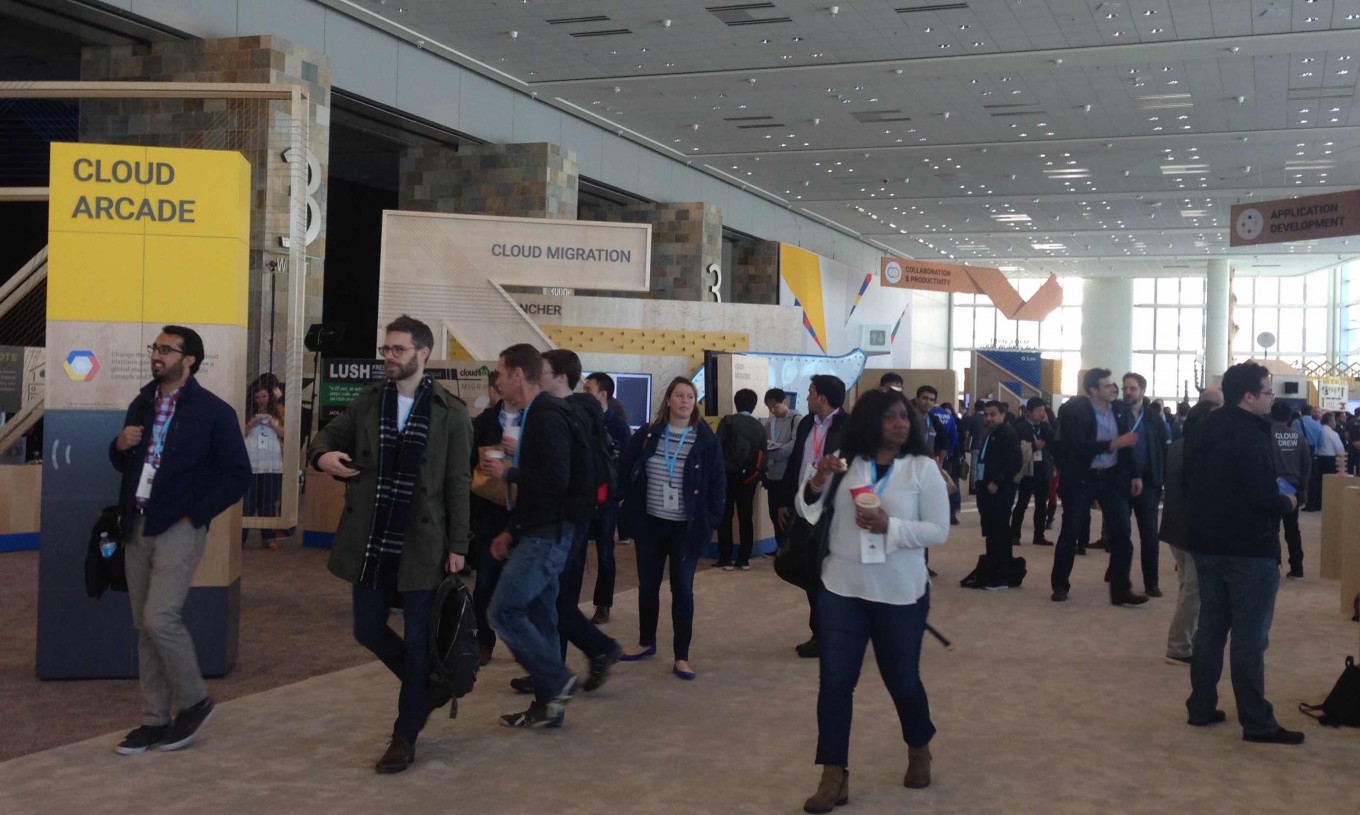Google in full gear to grab larger slice of cloud computing
Google’s Diane Greene was undoubtedly enjoying “good” momentum when she took to the stage to share the company’s vision of the cloud-computing business before an audience of thousands attending its major tech conference in San Francisco on Wednesday.
Change text size
Gift Premium Articles
to Anyone
 Digital collaboration: Google's senior vice president in charge of the company's cloud business, Diane Greene (left), and e-commerce platform eBay chief product officer R. J. Pittman discuss about how Google's cloud services support the operation of eBay, which is among Google Cloud's new marquee customers, during the Google Cloud Next 2017 conference in San Francisco on March 8, 2017. (JP/Hasyim Widhiarto) (JP/Hasyim Widhiarto)
Digital collaboration: Google's senior vice president in charge of the company's cloud business, Diane Greene (left), and e-commerce platform eBay chief product officer R. J. Pittman discuss about how Google's cloud services support the operation of eBay, which is among Google Cloud's new marquee customers, during the Google Cloud Next 2017 conference in San Francisco on March 8, 2017. (JP/Hasyim Widhiarto) (JP/Hasyim Widhiarto)
Google’s Diane Greene was undoubtedly enjoying “good” momentum when she took to the stage to share the company’s vision of the cloud-computing business before an audience of thousands attending its major tech conference in San Francisco on Wednesday.
Just last week, thousands of websites, including popular domains such as music and audio platform SoundCloud and question-and-answer site Quora, experienced a disruption for more than three hours because of technical glitches in the popular Amazon.com cloud service.
Amazon Web Services (AWS), the world’s biggest player in the cloud business, attributed the incident to human error, saying that a member of the Amazon Simple Storage Service (S3) team had input an incorrect command that led to the removal of a larger set of servers than initially intended.
Around the same time, a similar incident took place in Indonesia when local cloud service provider Biznet GIO Cloud failed to support its clients’ operations for several hours because of a power outage, leaving major clients such as popular e-commerce websites Bukalapak and Tokopedia unable to process online orders and payments.
Leading the keynote session on the opening day of the Google Cloud Next 2017 conference, Google cloud boss Greene did not name any rival. However, her opening remarks clearly underlined what Google’s cloud service is offering to existing business customers and potential clients: reliability.
Just like the Google search engine, Google Cloud Platform (GCP), Greene added, was designed to run at “five nines of availability,” a term used by people in the tech industry to say that it is 99.999 percent reliable.
“That’s how we design our cloud,” she said.

(Read also: Google's latest feature allows musicians to get real time updates)
Cloud computing refers to the delivery of on-demand computing resources, such as applications and data centers, over the internet on a pay-for-use basis. Under such a scheme, businesses can easily adjust their computing needs in response to fluctuations in demand, eliminating the need for massive investments into local infrastructure.
Despite being a major player in the tech industry, Google did not consolidate its cloud-computing business until late 2015 when it hired Greene, the co-founder and former CEO of cloud system developer VMware, to lead its cloud unit. Alphabet, Google’s parent, expects that the cloud sector would serve as an alternative source of revenue for Google, which has largely relied on advertising revenues.
Referring to estimates from the Synergy Research Group, Bloomberg reported that under Greene’s leadership, Google’s share of the so-called public cloud market, which includes data storage, computing and networking services, has more than doubled to about 5 percent since the second quarter of 2015.
The latest data from the research group, meanwhile, suggested that AWS still maintained its dominant share of more than 40 percent of the public cloud services market last year. In 2015 alone, AWS pocketed almost US$8 billion in revenues.
Meanwhile, the three main cloud providers — Microsoft, Google and IBM — have increased their worldwide market share by almost five percentage points over the last year and together now account for 23 percent of the total public cloud market.

(Read also: Beyond cat videos: YouTube will offer its own pay-TV service)
Google, however, maintained its confidence that its enormous cloud infrastructure and large pool of talents would make it possible to offer more innovations to support its business consumers.
The company has also spent a massive US$30 billion in capital expenditure on infrastructure over the past three years, prompting Alphabet executive chairman Eric Schmidt to make a bold suggestion for businesses to “leave the [cloud] infrastructure to us”.
“Why try to replicate that?” he told Google Cloud Next participants.
Google Cloud has a reputation of being the best suited for startups and consumer apps. Snapchat and Pokémon Go, for example, are currently among the major Google Cloud customers. Among the new marquee customers are global banking giant HSBC and ecommerce marketplace eBay.

On Wednesday, during the same forum, Google Cloud also announced the launch of the Video Intelligence application programming interface (API), which allows developers to search for specific objects within videos. The API, which is currently in a Private Beta, quickly annotates videos stored in Google Cloud Storage with video, shot and frame-level context.
Media organizations, for instance, can use the feature to reorganize their existing videos and create new monetization opportunities from their archived contents. “Understanding the rich content of videos has been a tremendous technology challenge for many years. In fact, many of us computer researchers often considered video as the dark matter of the digital universe,” said FeiFei Li, Google Cloud chief scientist of artificial intelligence and machine learning, providing an example from Google’s videosharing platform YouTube, which has more than 600 hours of videos uploaded every minute.
“Now, finally we are beginning to shine a light on the dark matter [with the API] and provide values to our customers who can use it to harness the enormous amount of information embedded in videos.”
Separately, Clement Teo, a principal analyst for global consulting firm Ovum, said many enterprises in Asia were just starting to get serious about digital transformation, opening up opportunities for Google to assist them with reliable cloud services.
The Singapore-based Teo also mentioned the importance of making local partnerships to prove commitment in the business.
“They [Google] will have to look for opportunities to partner locally, for example with Biznet in Indonesia, to serve local enterprises,” he told The Jakarta Post.
This article appeared earlier in The Jakarta Post's print edition on Friday under the title "Google in full gear to grow cloud computing".









